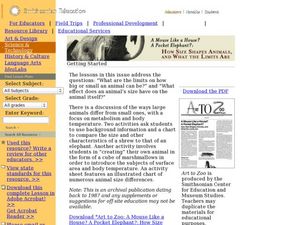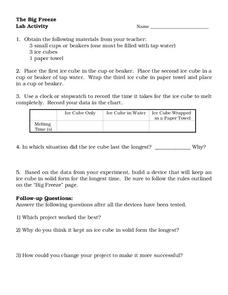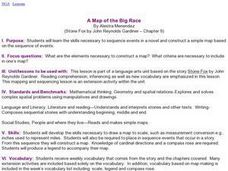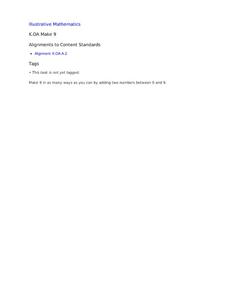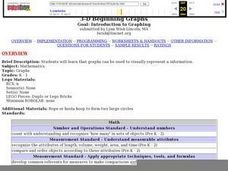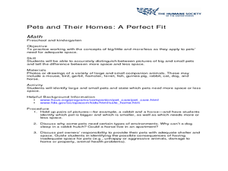Curated OER
How Size Shapes Animals
Students investigate how size affects large and small animals differently. In this animal lesson plan, students determine how size affects different animals by constructing their own animal out of marshmallows. Once students create...
Curated OER
Moving Mountains: Big Ideas Start Small
Students read case study about three students who led fundraising efforts for tsunami relief, discuss key concepts and vocabulary, identify problems in their own school or community, and brainstorm ways to solve problems.
Curated OER
Letter Writing Accuracy: Write it Big, Write it Small
Students write the letters of the alphabet. In this language arts lesson, students listen as the teacher says a letter. Students write the letter spoken by the teacher. Students write capital or lowercase letters.
Curated OER
How Big is the Sun? Exploring the Size and Scale of the Sun, Earth and Moon
Students explore the relative sizes of the Sun, Earth and Moon as they make an impressive large-scale model for classroom use throughout the unit.
Curated OER
How Big is a Foot?
First graders practice nonstandard measurement and estimating and measuring lengths of objects.
Curated OER
The Big Freeze
In this lab activity worksheet, students record the time it takes for an ice cube to melt in three different situations. After collecting data they design a container that will keep an ice cube in a solid state for as long as possible.
Curated OER
Cranes, Crosswalks, and Big Gulps
Learners watch a video and answer questions based on wildlife jobs. In this wildlife lesson plan, students learn that biologists don't just play with animals but that there is a lot of study involved.
Curated OER
What Big Teeth You Have:
Students make their own tooth impressions of a sharp and a flat tooth and compare the differences. They make impression of fossil teeth from dinosaurs comparing the sharp and flat teeth and learning about their uses.
Curated OER
Jesse's Big Change
Students explain assets, liabilities and expenses. They record information on income statements and balance sheets and brainstorm opportunities to make money work for them.
Curated OER
Big Beans, Little Beans
Pupils measure and note the variation in the lengths of lima beans. They compare the growth rate of different sized beans.
Curated OER
A Map of the Big Race
Pupils read a novel and practice putting the events into the correct sequence. Using the text, they create a map showing the events of the race in order and a legend. They must use vocabulary from previous chapters and make their map...
Curated OER
Big Bubble Letter Poster
In this getting to know you learning exercise, students follow the directions to create bubble letters for their names and then fill each letter with information about themselves.
Curated OER
Counting On to the Next Ten
Children count on by amounts that result in moving to the next set of 10. (They count on 4 from 26 and get to 30; or they count on 7 from 33 to get to 40.) Five practice exercises each have a nice big box where small hands can write...
John Talavera
Autism iHelp – Opposites
In/out, up/down, big/small; understanding opposites is a fundamental vocabulary-building skill. This app uses real-life photographs, to introduce the learner to the concept of opposites. Learning opposites is necessary for understanding...
Curated OER
Megabeasts
Create larger-than-life insects for the classroom. Bugs are usually pretty small, but during the Jurassic period they were huge. Kids use diagramming and scale conversion to enlarge a modern day insect so that it is as big as its ancient...
Illustrative Mathematics
Make 9
Learning how numbers are put together as parts and wholes is a big step in building the foundational number sense of young mathematicians. Here, children are given a number less than 10 and are asked to find as many pairs of numbers as...
MARS - Mathematics Assessment Resource Service
Applying Properties of Exponents
The properties of exponents are all linked together and it is your mathematicians' job to discover and apply those rules. The comprehensive lesson plan begins with a pre-assessment task to check for prior knowledge and then goes into a...
Curated OER
What Physical Activities Do Sneakers and His Friends Do? Lesson Idea
Young scholars listen to the story Big News! They think of other physical activities that Mr. and Mrs. Legs and their little spiders may do together.
Curated OER
3-D Beginning Graphs
Students explore the concept of big and small. They collect objects from the classroom, sort them by size, and create a graph using Duplo stacking blocks.
Curated OER
Science-Unit on Matter-Gases
First graders understand that gases take up space even though you can't see or smell it. This is done through many experiments like trapping air in different sized bags, using balloons and plastic bottles, and blowing bubbles. They...
Fuel the Brain
Represent Fractions and Make Different Representations of the Same Fraction
Understanding fractions and how big or small each fraction represents is key to solving these story problems. Determine how much pizza was eaten by two different people by asking your mathematician to use their fraction knowledge!
Curated OER
Biomagnification
Students use real data to create an algebraic equation. They explain how the build up of small levels of contaminates can quickly become detrimental to species higher in the food chain.
Curated OER
Pets and their Homes
Students explore the space needed for an animal to live in. In this pets lesson plan, students view pictures of animals and decide which one needs more space or less space to live. Students discuss animals environments and why certain...
Curated OER
Tessellations WOW!
Students identify and manipulate shapes to create tessellations. In these geometry/spatial relations lessons, the students use of a variety of modalities such as literature, music, writing, and art as introductions to the concept of...
Other popular searches
- Comparing Big and Small
- Big and Small Animals
- Dinosaurs Big and Small
- Compare Big and Small
- Big or Small Numbers
- Big and Small Communities
- Sizes Big or Small
- Big and Small Businesses
- Halloween Big and Small
- Small Words in Big Words
- Small and Big Objects
- Big and Small Concept


